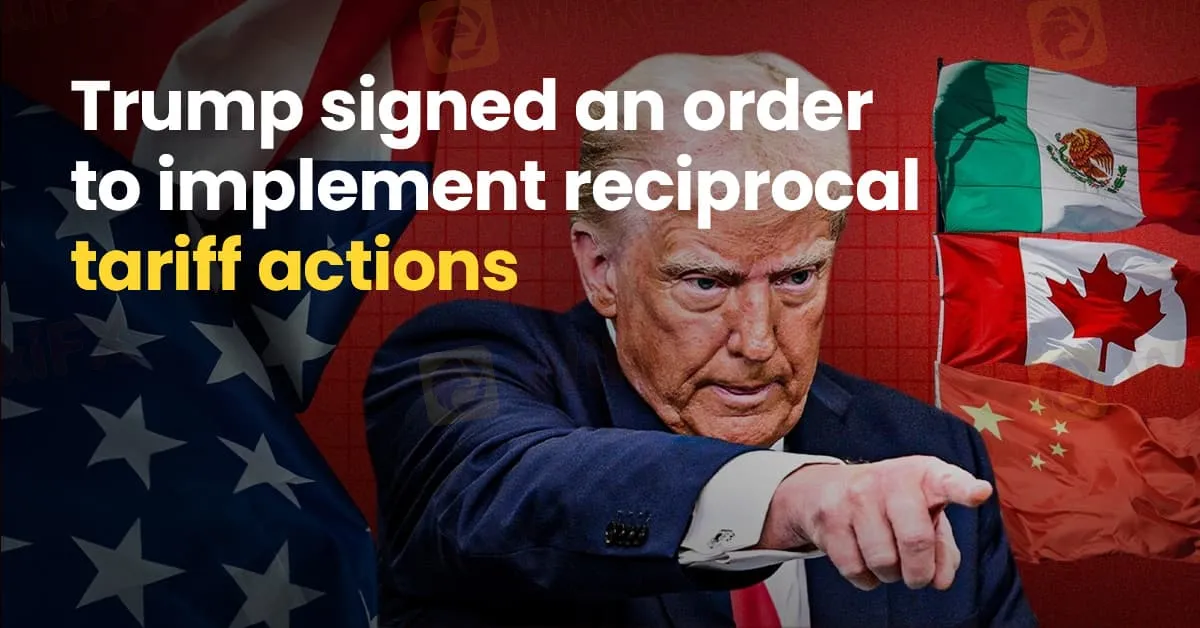简体中文
繁體中文
English
Pусский
日本語
ภาษาไทย
Tiếng Việt
Bahasa Indonesia
Español
हिन्दी
Filippiiniläinen
Français
Deutsch
Português
Türkçe
한국어
العربية
Trump signed an order to implement reciprocal tariff actions
Abstract:The directive includes calculating duties to match those other countries charge and addressing non-tariff barriers such as vehicle safety rules and value-added taxes that hinder U.S. exports.

On February 13, 2025, President Donald Trump signed a memorandum directing his economic team to develop plans for implementing reciprocal tariffs on all countries that impose tariffs on U.S. imports. This strategy aims to ensure fairness by matching the tariffs charged by other nations on American goods. The directive includes calculating duties to match those other countries charge and addressing non-tariff barriers such as vehicle safety rules and value-added taxes that hinder U.S. exports.
According to Reuters, the Key Aspects of the Reciprocal Tariff Plan include:
- Targeted Countries: The plan focuses on major trading partners, including China, Japan, South Korea, and the European Union.
- Implementation Timeline: While the memorandum initiates the development process, the new tariffs are not expected to be levied immediately. White House officials have indicated that the administration aims to move quickly, suggesting a timeline of “weeks” rather than “months” for implementation.
- Economic Implications: The announcement has raised concerns about potential economic repercussions, including fears of a global trade war and the possibility of increased consumer prices. However, Wall Street responded positively, relieved that new tariffs were not immediately implemented.
Context and Background
This move is part of President Trump's broader efforts to address trade imbalances and promote fair trade practices. The reciprocal tariff plan builds upon previous actions, such as the 25% tariffs on steel and aluminum imports and the 10% tariffs on Chinese goods. The administration's approach reflects a shift towards more protectionist trade policies, aiming to level the playing field for U.S. industries.
Potential Global Impact
The implementation of reciprocal tariffs could lead to significant changes in global trade dynamics. Countries affected by these tariffs may seek to negotiate trade agreements to reduce or eliminate the new duties. Additionally, businesses may need to adjust their supply chains and pricing strategies in response to the changing trade environment.
As the Trump administration moves forward with this plan, the global community will be closely monitoring the developments and their potential impact on international trade relations.

Disclaimer:
The views in this article only represent the author's personal views, and do not constitute investment advice on this platform. This platform does not guarantee the accuracy, completeness and timeliness of the information in the article, and will not be liable for any loss caused by the use of or reliance on the information in the article.
Read more

TradingPRO: A Closer Look at Its Licences
In an industry where safety and transparency are essential, the regulatory status of online brokers has never been more important. For traders seeking to protect their capital, ensuring that a platform operates under recognised and stringent oversight can make all the difference. Keep reading to learn more about TradingPRO and its licenses.

Oil Price Breakout Incoming? Investors Should Stay Alert
Oil prices are hovering around a critical level, with potential yet to be fully unleashed. Investors must prepare for sudden changes.

New SEBI Regulations on Intraday Trading
The Securities and Exchange Board of India (SEBI) has implemented revised regulations on Intraday trading, with effect from November 20, 2024. These regulations are meant to lessen risks and prevent speculative trading practices.

Top Forex Trading Strategies Every Trader Must Implement
Successfully navigating the fluctuating forex market landscape requires more than having a high-risk appetite. It requires effective strategies that assure you gains even during the market fall. Let’s go through the strategies many traders implement to gain.
WikiFX Broker
Latest News
ASIC Urges Financial Licensees to Fix Register Errors Before 2026 Deadline
eToro Review 2025: Top Trading Opportunities or Hidden Risks?
How much money will you earn by investing in Vantage Broker?
IronFX vs Exness Review 2025: Comprehensive Broker Comparison
Fraudsters Are Targeting Interactive Brokers' Users with Lookalike Emails
Everything you need to know about ADSS
SkyLine Guide 2025 Malaysia: 100 Esteemed Judges Successfully Assembled
Vantage Markets Review 2025: Trusted Forex and CFD Trading Since 2009
Top Tips to Choose the Best Forex Broker in 2025
SEBI Notifies New F&O Rules for Investors - New Derivative Trading Limits & More Amendments
Currency Calculator


